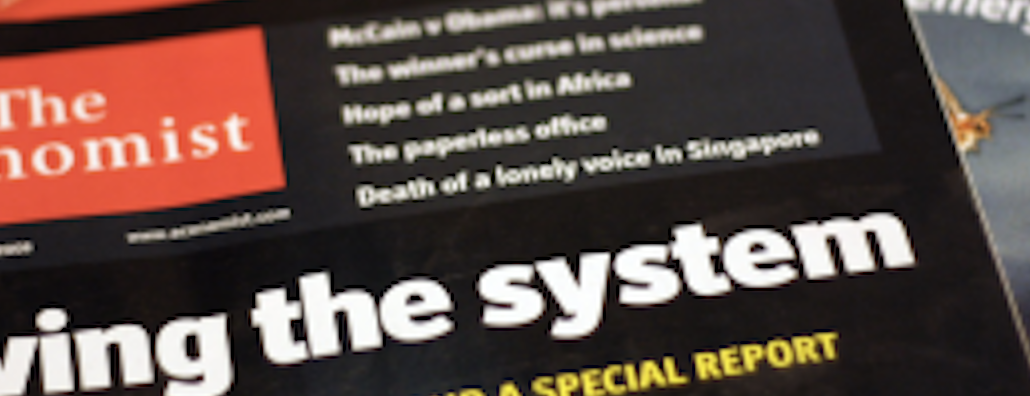Save 50% on a 3-month Digiday+ membership. Ends Dec 5.

The Economist isn’t a scale proposition. The bulk of its revenue comes from its paid subscriptions, 304,000 of which are digital, and 1.5 million print. Not having a mammoth audience means inventory has often been sold out four months out of 12, which has meant it’s too often had to do what would frustrate any publisher sales team: Turn away ad spend.
That’s why in 2014 it set itself a strict goal to drive more than 50 percent of its programmatic revenue via audience extension campaigns. Fast forward to today, and its year-on-year programmatic revenue has grown 200 percent, equating to millions of pounds.
The Economist hasn’t had to accept rock bottom prices to shift remnant ad inventory on open exchanges. It maintains price parity on direct sales and programmatic sales. But it uses the open exchange as a lead generation tool.
“We can see if an advertiser hasn’t been successful with a bid on the Economist and we’ll afterwards contact them and start a conversation with them about what they need, and for what price,” said The Economist’s svp of digital products revenue Ashwin Sridhar. “Those may start as programmatic discussions, but we’ve gone on to make print and direct sales from those conversations too.”
An even bigger part of its programmatic revenue growth has been from using ad tech tools like Google’s audience extension products to bulk up its off-site audience targeting capabilities for advertising clients.
It’s also redirected the same technique to drive its own circulation growth, and in doing so driven a further 5,000 paying subscribers, and 7 million additional readers. In the process, it’s halved the amount it would normally spend to acquire new subscribers.
“This is a big deal,” said Sridhar. “It fundamentally changes the economics of our acquisition model. Acquiring subscribers used to be an expensive affair, and we’ve now brought that down dramatically.”
Ad position: web_incontent_pos1
Like most marketers it’s been trying to move away from the scattershot method of blanket targeting readers with brand awareness messages, and using its own audience data to identify other potential audiences outside of its own site borders.
It ran a provocative “Raising eyebrows and subscriptions” brand campaign with Proximity London, which won a Gold Cannes Lions in June. The campaign ran with attention-grabbing messages such as “If you want to be a CEO, grow some,” which led readers through to a destination page with related, free-to-read Economist content like this article: “The Look of a Leader.”
It’s also used ad tech tools to determine the sweet spot for directing another message to the same reader, with a suggestion of additional content they can read — a process repeated until the timing is deemed fit to serve a subscriptions offer message.
It was able to retarget people off its own site, across others like CNN and the Guardian, by using DoubleClick’s audience extension tools. “This is a far more scientific approach to acquiring subscribers, by leading with insights and ensuring we’re not wasting marketing spend. There’s no spray and pray and no bombarding people. And it ensures we continue to grow our subscribers at a reduced rate,” said Sridhar.
There’s plenty of room for further development of this method, which The Economist is now rigorously exploring. It runs continuous A/B tests to see what readers and subscribers respond to. “We didn’t have the right subscription journey mapped out before, or the right attribution model in place. Now we understand where a person is on their subscription journey very clearly. It’s made the whole process more efficient.”
Ad position: web_incontent_pos2
It’s found that viewability doesn’t matter as much when it comes to customer acquisitions, as other metrics, like time spent for example.
“We wanted to understand the impact viewability has, and realised we don’t need 100 percent viewability because the cost per acquisition goes up. Viewability is important but focusing on it alone leads to skewed results, and you may get the acquisitions but at a higher cost. A lot of our time now is spent looking for things like this and running tests,” he said.
More in Media

What publishers are wishing for this holiday season: End AI scraping and determine AI-powered audience value
Publishers want a fair, structured, regulated AI environment and they also want to define what the next decade of audience metrics looks like.

Digiday+ Research Subscription Index 2025: Subscription strategies from Bloomberg, The New York Times, Vox and others
Digiday’s third annual Subscription Index examines and measures publishers’ subscription strategies to identify common approaches and key tactics among Bloomberg, The New York Times, Vox and others.

From lawsuits to lobbying: How publishers are fighting AI
We may be closing out 2025, but publishers aren’t retreating from the battle of AI search — some are escalating it, and they expect the fight to stretch deep into 2026.
Ad position: web_bfu
